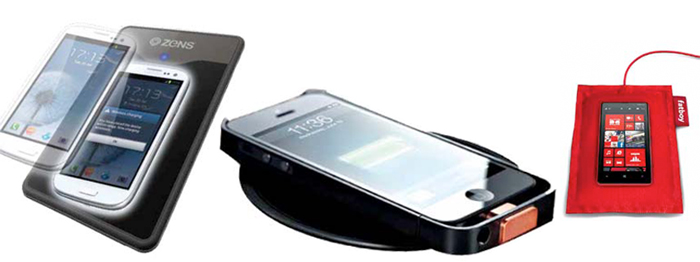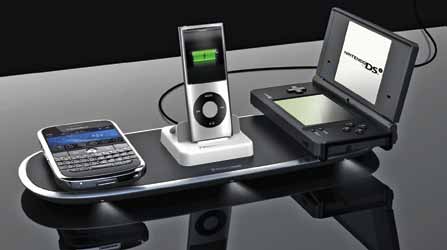
You place your phone on your bedside table, and it automatically starts charging. You place your hand-blender on the kitchen counter-top and it charges itself. You walk into a coffee shop or airport lobby, and your phones and tablets get a full power boost even as you recharge your-self with a coffee. That would really feel good, right? Well, such visions of ‘wireless charging’ are no longer a fantasy. Inductive charging or wireless charging technology is gradually stabilising, and gaining popularity.
Silicon designers and manufacturers, including IDT, Texas Instruments, Freescale Semiconductor and Intel, are focusing on wireless charging chips (transceivers and receivers).
The latest mobile phones, such as the Nokia Lumia 920 and Samsung Galaxy S4, are capable of wireless charging. There are wireless charging sleeves for the iPhone and other devices, and there are dozens of wireless chargers (charging pads) available in the market from Duracell, Energizer, etc, including those from JBL and Panasonic that double up as music players or alarm clocks. Food chains like Starbucks and McDonald’s are piloting wireless charging services at their outlets, while building material manufacturers like DuPont are thinking on the lines of embedding wireless charging chips into kitchen countertops. Car manufacturers are incorporating in-car wireless charging for mobile phones, and technologies like Qualcomm Halo promise wireless charging of electric vehicles.
On top of that, there are also signs of emerging standards. The Wireless Power Consortium (WPC) has a significant head start in this race. It has already standardised Qi, but seems to be in for serious competition as the Power Matters Alliance (PMA) and the Alliance for Wireless Power garner increasing support and work towards standardising their specifications too.

Here is a quick round-up of the major players, and some of the recent developments in the wireless charging space, which go to show the fast-paced developments in this area.
Qi vs Power 2.0
Power 2.0 emerging as a notable rival to Qi is perhaps the hottest topic in the wireless charging space today!
The Powermat charging mat was one of the earliest in the wireless charging space, having been launched as early as 2009. Although one of the key players in the standardisation of the Qi format, Powermat backed out from the WPC, frustrated by what it thought was a slow rate of adoption of Qi. Thereafter, Powermat, along with Procter and Gamble (P&G), founded the PMA to garner support for, and standardise a wireless charging specification (dubbe Power 2.0) based on the Powermat. Since then, Qi and Power 2.0 have become the two most aggressive competitors in the wireless charging space.
[stextbox id=”info” caption=”The basis of wireless charging”]“Wireless charging, as the name suggests, charges the batteries of smartphones and other portable devices wirelessly. One does not need to connect any wire to the power socket and charge the device. The user can simply place a phone with wireless charging capability on a charging pad for it to recharge,” says Ravi Lakkundi, product manager, Harman India.
Wireless charging or inductive charging is based on the fundamental principles of electromagnetic coupling. This requires two coils: a transmitter (which typically resides in a charging pad or mat) and a receiver (which resides in the device or its charging sleeve). It works by passing a current through a transmitter coil to generate a magnetic field, which creates electric current in a similarly-sized and oriented receiver coil in the other device. The generated current is used to charge the device’s battery or run it directly. For inductive charging to work, the two coils have to be placed close to each other. Move them apart and the efficiency of energy transfer drops drastically.
A more recent technology, called resonant inductive coupling or electro-dynamic induction, promises to work even when there are greater distances between sender and receiver coils. That is, one would not have to rely on a charging mat, and can instead convert whole surfaces like tables and kitchen counter-tops, or even whole rooms and lounges, into wireless charging areas. Resonant inductive coupling involves the near-field wireless transmission of electrical energy between two coils that are tuned to resonate at the same frequency.
Technically, the key difference between these two methods is the coupling factor between the transmitting and the receiving coil. A high coupling factor means that both coils need to be in close proximity with good alignment. A lower coupling factor enables a wider distance and spatial freedom in receiver placement with respect to the transmitter.[/stextbox]
WPC’s Qi specification enables any Qi-certified device to charge on any Qi-based charging pad. The Qi standard specifies transmitter topologies and ensures backward compatibility with existing WPC receiver products. The transmitters can use one or several coils (individually or simultaneously) to generate the magnetic field. The initial transmitter topologies use close magnetic induction coupling, and rely on using between three and eight coils to enable X and Y spatial freedom. The Z distance between the transmitter and the receiver coil is typically 5 mm. Lately, the WPC has proposed a new transmitter type with 5cm Z spatial freedom using adaptive resonant magnetic principles, while maintaining backward compatibility with existing WPC induction-coupled receivers. Hence, Qi now supports both inductive and resonant charging, spatial freedom, and intelligent power management.





